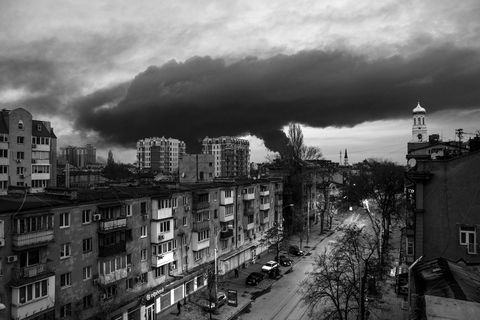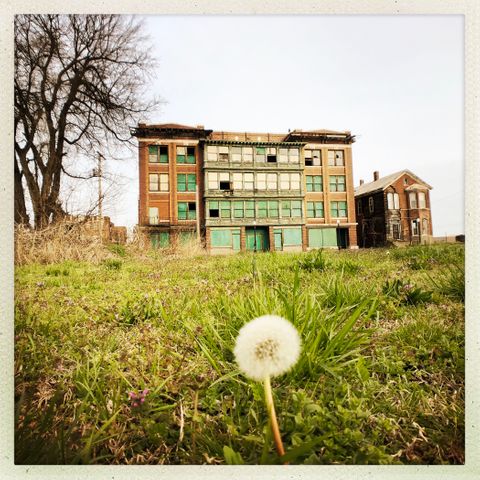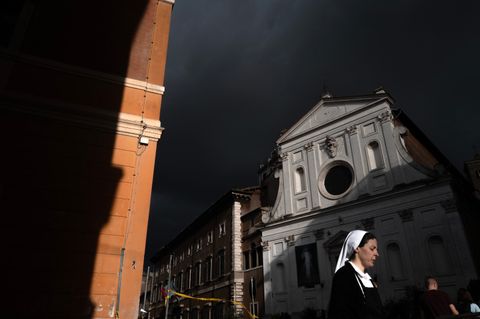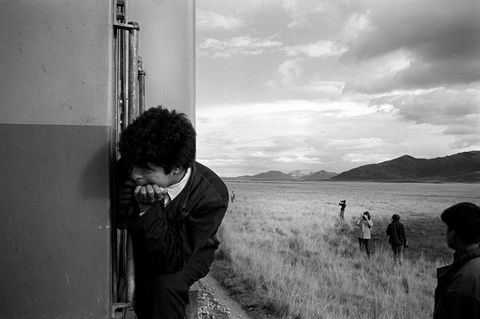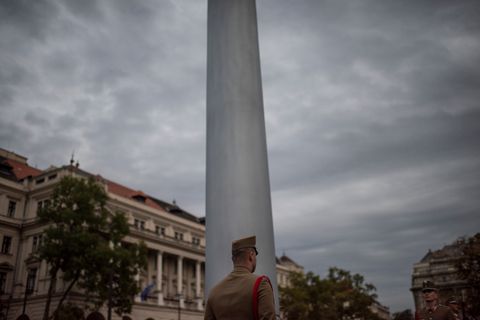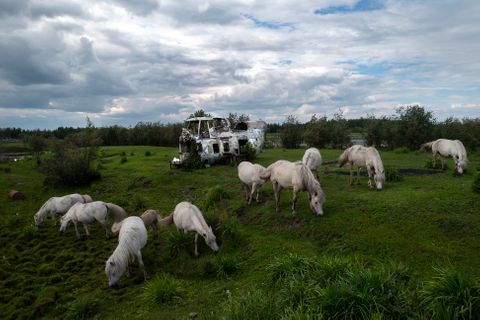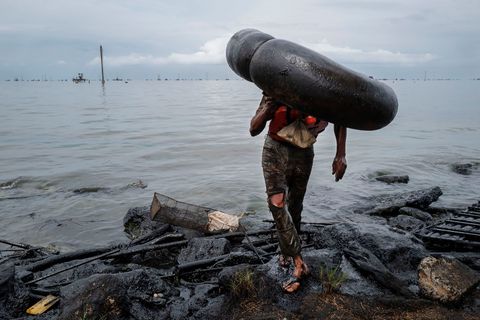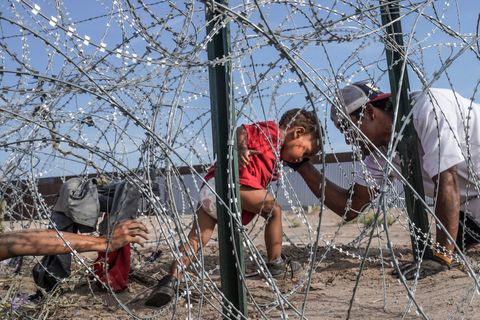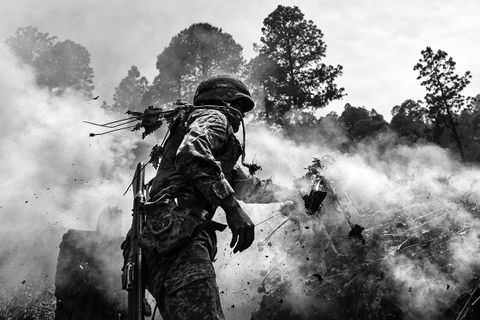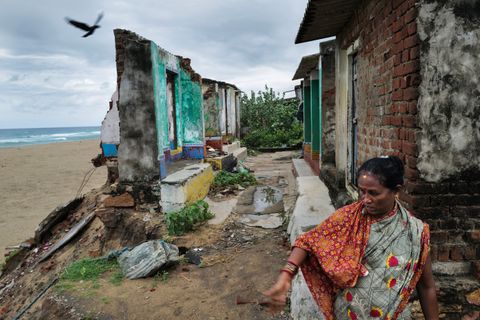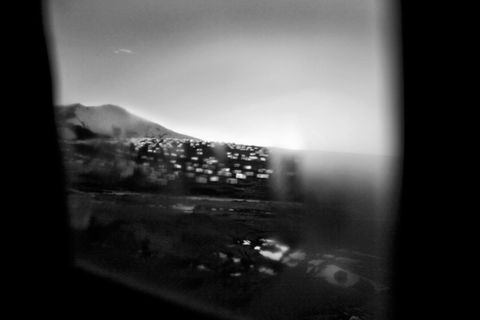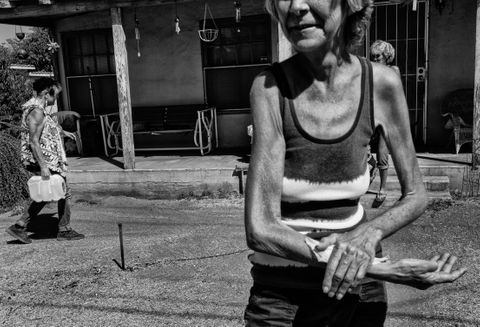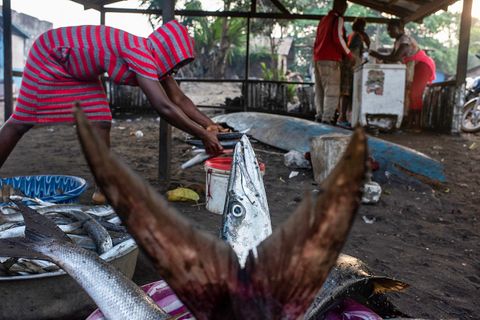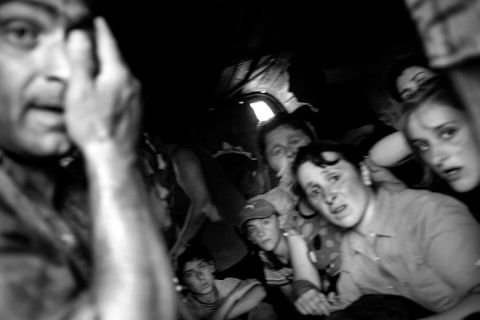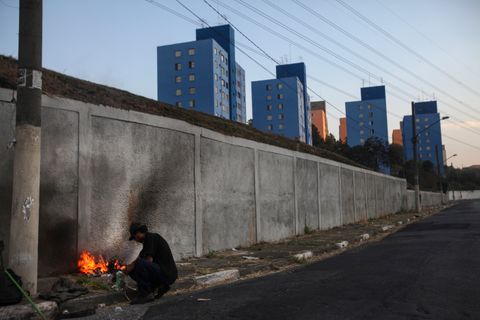Portfolios
Imperium: Ukrainians Endure
In February of 2022 Russian President Vladimir Putin ordered the unprovoked and brutal invasion of Ukraine. For Putin, the breakup of the Soviet Union was the worst event in the country’s history and he still doesn't see Ukraine as a sovereign nation. The Kremlin sees it as part of a greater Russian empire, one they will bring back in the fold no matter how many lives it takes, how much misery it brings.
For the past 3 years, Ukrainians have been under merciless artillery, drone and missile attacks. Civilians are frequently targeted and killed. The scenes are bleak: black smoke rising above Odesa, once a playground for Russian oligarchs, families burying their dead, internally displaced people receiving food handouts as others board buses for destinations many miles from their homes.
Along the country’s coal corridor, miners work in perilous conditions to keep the energy sector functioning and overburdened cars venture down lonely highways, heading west and away from the fighting.
Now that a pro-Russian administration is in the White House, Ukrainians fear all that they will have to give up to have peace, or at least a cease fire. The images of the missing and imprisoned are on display across the nation, a reminder of what is at stake for a country that has seemingly been fighting for its survival since day one.
The Fading City
Rural areas throughout America are rapidly depopulationg and nowhere is it more apparent, and acute, than in Cairo, Illinois. Situated at the southern tip of Illinois, at the confluence of the Mississippi and Ohio Rivers, Cairo, once an economic powerhouse, is now a city overrun by kudzu and depleted by population flight. The decay is evident in the empty signs and buildings. Theater marquis have nothing to say and buses no longer move.
Two housing complexes are being shut down resulting in a large portion of the population moving to neighboring towns. Schools, with diminishing student bodies, are hanging on by their fingernails. Cairo, a city steeped in history, is slowly finding itself becoming just that: history.
A Farewell to Francis
They came to Vatican City and Rome by the thousands to say goodbye to the "people's pope." Francis was the first pontiff from Latin America and was the principal force in opening up the Catholic church to more people, principally the underrepresented, disadvantaged, and impoverished.
St. Peter's Square and Basilica were filled with people, some emotional, that came to see the pontiff lying in state. Through gestures of humility, inclusive prayers, and the presence of a remarkably diverse crowd, the farewell captured Francis' vision of a Church striving to open its arms wider to the world. This included his burial at the Basilica Santa Maria Maggiore in a neighborhood that he embraced.
Following his funeral, Catholics waited to see if the church would turn more conservative when naming Francis' successor. The answer came rather swiftly with the appointment of Pope Leo XIV, the first pontiff from the United States by way of Peru. It appears that Francis’ influence and leanings will continue.
Awaiting the Rain
Peru has always been a deeply personal place for me. It was where I fell in love with travel, with photography. It is where I connected with my mother's side of the family. That connection has only grown deeper.
Peru never ceases to surprise, frustrate, and inspire you. I first traveled there in the late 1980s when the country was in political free fall and the currency had the value of confetti. It was a powerful awakening to the world outside the bucolic suburb I grew up in. I've never stopped returning.
The photographs here were made all over the country between 1993 and 2021. They are largely personal and free of the pressures of assignment work and deadlines. For me, Peru was an escape visually. A place brimming with melancholy and shades of grey. Perhaps its the history, struggles for most to make a living day to day or like the family waiting on a corner in one of the frames in the gallery, waiting for a bus that on any given day, may or may not come for them.
The New Autocrats
Democracy in Eastern Europe has paved the way for a new breed of Autocrats to strengthen their authoritarian grip on their respective countries. Led by Hungary's President, Viktor Orban, governments in Poland, Romania and the Czech Republic are reining in the freedom of the press, attempting to pack the judiciary and accused of being awash in corrupt practices.
Farmers complain of decaying infrastructure preventing them from getting goods to market. In Romania, secular citizens worry about the growing power of the Orthodox Church and vanishing borders between church and state. In Poland, protesters voice their opposition to the dismantling of the country's constitution. Will populism unravel democracy and create a new autocratic Iron Curtain?
East of Everything
"Even in Siberia, there is hapiness." - Anton Chekov
Rapidly melting permafrost is altering Siberia's landscape, economy and demographics. Birds and fruits never seen before are taking root, reliable generators of income including fish and game are becoming harder to get to market. The ice highways, the crucial network stitching this remote world together are thawing out earlier and freezing later, stranding trucks in muddy quagmires.
The legendary Siberian winters may become just that, legend.
The Undoing of Venezuela
For decades Venezuela was the envy of Latin America. Now the second "Bolivarian Revolution" has left the economy in tatters. Over 9 million Venezuelans have fled a country where infrastructure, basic services and opportunities lie in ruins. The country continues to suffer under the Maduro regime claimed victory in the most recent election, one that has been deemed fraudulent by most observers.
Violent protests rocked the streets of Caracas and border areas near Colombia throughout 2019, one of the country's most tumultuous years. In the capital families laid loved ones, killed by police and military forces, to rest following the clashes. Illegal mining ravages the southern jungles where people desperate to make money in a collapsed economy hope to find gold.
To the west, in Maracaibo, once a symbol of the OPEC member's prosperity based on petroleum, neighborhoods lie abandoned. The residents, millions of them, have left to other nations in the Americas or Europe. Malnutrition and infant mortality lurk on every street of a city that once boasted non-stop flights to European capitals and the Middle Eastern oil centers. Now, the city can barely keep the lights on. The infrastructure that made the city a petroleum powerhouse is disintegrating, leaving Lake Maracaibo, South America's largest, a polluted mess.
The fishing communities living on the shoreline have to exist in a perpetual soup of water and oil, bubbling up from broken pipes and wells. A fishermen exiting the lake on an inner tube, when asked about what he had caught that day, replied "solo petroleo." Only petroleum.
The Vanishing Colorado River
At the mouth of the Colorado River in northern Mexico, water that once surged into the sea now barely trickles through a parched delta. These photographs document the lives of the people who remain in this fragile landscape, fishermen, farmers, and families whose way of life is slowly evaporating. Once a vast and thriving wetland, the Colorado River Delta has become a stark symbol of how climate change and overuse are rewriting the natural order of the American Southwest and northern Mexico.
For decades, dams and diversions upstream have reduced the river to a shadow of itself. Rising temperatures and prolonged droughts, the sad hallmarks of human-induced climate change, are accelerating its decline. Yet amid the desiccated estuaries and cracked riverbeds, communities adapt in quiet, powerful ways: replanting native vegetation, reviving ancestral water knowledge, and calling for international cooperation to restore ecological balance. These images aim to capture the resilience in a region where water is life, and its absence is a profound reckoning.
Al Norte - Migration to the US
For decades migrants have been moving north through Latin America to find work and better life for their families in the United States. This set of photographs depicts that movement, from Guatemala, across the Suchiate River into Mexico, north via train into Chiapas and finally to the border with the United States.
The photographs were made between 2014 and 2023. The politics of immigration is always tempestuous, but for the migrants it remains a constant state of fear, nervousness, exhaustion and anticipation. This shows migration during "surges," and at times when Mexico promised a crackdown in exchange for some economic trade off with its northern neighbor.
The focus of this work is on Latin Americans that made the journey, from Mexico, El Salvador, Venezuela, Guatemala, Hondouras, and Colombia. They say goodbye to family and friends in their villages and then depart on a sometimes month's long trip. The journey has become increasingly perilous with gangs and cartels preying on the vulnerable.
Mexico's Misery
The term ‘drug war’ only barely describes what is going on in Mexico. America’s hunger for drugs is taking a brutal toll on the country. Homicides and drug addiction rates in Mexico surged to historic highs. What was the impact in Mexico of its soaring heroin exports to the United States? Why were murders spiking in places like Acapulco that weren’t drug-cartel strongholds? How was drug violence changing as traffickers increasingly targeted Mexicans as consumers? The evidence of the carnage is inescapable in many of Mexico’s cities and towns. Cesar Corona is 27 and has been addicted to heroin since his mother committed suicide when he was 18. He spends his days injecting “Belushis,” a combination of heroin and methamphetamine into his neck within site of the US/Mexico border. In Jalisco, a family grieves over the loss of a recently murdered relative. She had miraculously survived 2 gunshots to the head, only to be gunned down by sicarios, or assassins, a month later. Acapulco, once a celebrated seaside resort has descended into a homicidal hell, many of its neighborhood devoid of police, law and increasingly, residents. It is the second most dangerous city in the world. In Mexico’s “Tierra Caliente,” or Hot Land, local citizens have taken up arms in an effort to defend themselves from “El Tequilero,” a drunken psychopath who has been murdering and kidnapping residents of this opium growing region. As long as the thirst for drugs keeps growing in its northern neighbor, Mexico will remain gripped by the violence and corruption that have consumed much of the country.
A Rising Threat Along the Bay of Bengal
Along the Bay of Bengal, where nearly 1.4 billion people live, water has become perilously unpredictable. On the coast of India’s Odisha state, repeated floods swallow villages. In Sri Lanka, a scarcity of water is carving cracks where ponds once formed and drying out paddy fields. In the mangrove swamps of the Sundarbans forest that straddles the border between India and Bangladesh, rising seas and cyclones are driving people inland, to congested cities like Kolkata for work.
Climate change is warming waters, shifting ocean patterns and transforming the region’s yearly monsoon from a reliable lifeline into a menace.
The water in the bay is rising faster than in other major bodies of water. The challenges confronting nations adjacent to it, densely populated along their coasts, probably foreshadow the struggles ahead elsewhere on Earth.
Rinconada: City of Broken Dreams
The chaos sits at the foot of a glacier in southeastern Peru, between 5,000 and 5,400 (16,400-17,200 feet) meters above sea level. There 50,000 people dig their way into the mountain side looking for their fortune in gold. Rinconada is a brutal place, devoid of sanitation, law, proper sewage and recourse. Alcoholism and accidents are commonplace. Doctors and lawyers are among those desperate to find the metal in the mountain, having abandoned their practices for the promise of instant fortune.
The Driest Seasons
California endured an historic drought between 2010 and 2014. In the state's agricultural heart, the Central Valley the ground is thirsty, the earth is sinking and towns are being abandoned. Families are without water and increasingly, people are without work as farmers let fertile land go fallow.
If you want to dig a well, prepare to wait a year or longer just go get the land surveyed. Big agricultural firms have no problem absorbing the costs of digging deeper. They are cashing in on the almond rush. To grow a single nut requires a gallon of water.
Emergency measures are finaly being put into place after the Sierra Nevada, the state's main source of water, received a paltry five percent of its normal winter snowfall. Hopes are evaporating that relief will ever come.
These photographs were made over the course of 2014 in towns and famrs throughout the Central Valley.
Liberia's Long Road Back
Few places in the world have endured as much pain and hardship as the small West African country of Liberia. Two brutal civil wars traumatized the nation and in 2014 an Ebola epidemic ravaged the country, killing thousands. The resilient people of what is by many measures, the world's poorest nation, are trying to feel optimistic about the country's future. Liberia, founded by freed North American slaves, has a unique history which is woven into its faith, language and customs. These photographs were made in early 2019 and are just a brief glimpse into the life of Liberia and her people as they slowly make their way down the long road back.
Two Countries
On August 3, 2019, Patrick Crusius killed 22 people and wounded scores more in the border city of El Paso, Texas. The 21-year-old confessed to police after he surrendered that he had been targeting Mexicans. He drove over 600 miles from his home to commit the terrorist act.
Mass shootings happen in the United States with such regularity that most don’t manage to break into national headlines. There were more than 400 mass shootings in the US in 2019 alone. El Paso and Ciudad Juarez, Mexico are more than just sister cities. They share a common culture, geography and a population that have called both places home for generations. The attack at an El Paso Walmart where Mexican nationals frequently shop cut deep on both sides of the border. Funerals, including one for schoolteacher Elsa Mendoza Marquez, a victim, took place in Mexico. The Flores family, originally from Ciudad Juarez, have lived in El Paso for a generation. They lost both of their parents.
Five Days
In August 2008, tensions over the "breakaway republic" of South Ossetia between Russia and Georgia boiled over into a conflict that left hundreds dead and thousands wounded. Russian troops invaded Georgia as far as Gori, a city near the center of Georgia and the birthplace of Josef Stalin, one of the Soviet Union's most infamous and brutal dictators.
South Ossetia, a republic recognized by few countries, is still a Russian satellite state in the restive Caucasus region. The International Court in The Hague opened an investigation into war crimes committed by Russian, Georgian and Ossetian forces during the conflict.
Selva de Cimento
For years I had been trying to get to Brazil. Her music, people, sensual language and geography seemed unreachable. All my plans to land in Rio or Sao Paulo were thwarted by circumstance. In 2013 I finally made the first of two month long trips. These photographs, from that first trip, stemmed from wanderings in the urban corridors and nether worlds of Rio de Janeiro and Sao Paulo, the country's two megacities.
The extremes of these cities were overwhelming. Horrible income disparity, impossible geographic beauty, endless seas of cement, racial tension, a culture of violence passed from generation to generation. Complex doesn't scratch the surface. The country is frustration, joy, desperation, fear, love, sweat and exasperation all boiling together. I miss it dearly.
